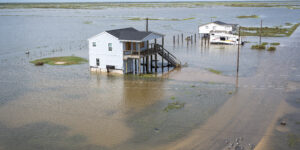In this edition of Risk Alerts: the shifting gun liability landscape, outdated building codes, and how copycat packaging is leading to accidental THC ingestion—especially in children.
Gun manufacturers under fire.
The gun liability landscape is shifting, leaving insurers on the hook for multimillion-dollar verdicts, says Charlie Kingdollar in a recent article on HB Litigation Conferences.
“Insurers and reinsurers providing liability coverage for gun manufacturers did so believing that federal law protected gun manufacturers from liability arising from shootings under the federal Protection of Lawful Commerce in Arms Act (PLCAA). It seems likely that policy terms and conditions as well as pricing of the risk reflected that perceived liability protection,” he writes.
But on Feb. 15, Remington Arms, which manufactures the Bushmaster AR15-style rifle, agreed to pay $73 million to settle a lawsuit filed by the families of nine of the victims of the 2012 Sandy Hook Elementary School shooting. That settlement will be paid by four of Remington’s insurers, he says.
The Connecticut plaintiffs filed their suit under the Connecticut Fair Trade Practices Act, alleging that the Bushmaster was a combat weapon and that Remington improperly marketed it to civilians. The Connecticut Supreme Court ruled that the federal PLCAA did have some carve-outs for state laws and declined Remington’s request to dismiss the lawsuit.
Kingdollar says it seems likely the lawsuit will be used as a template by plaintiffs in other states that have similar statutes, which could result in burgeoning litigation against gun manufacturers. How many other types of firearms might be deemed “combat weapons”?
And will wholesalers and retailers also be found liable?
Source: “The Shifting Gun Liability Landscape: Plaintiffs Say Companies are Marketing Illegally, Insurers End Up Paying,” HB Litigation Conferences/Charlie Kingdollar, 2022
Most states not enforcing up-to-date building codes.
A recent analysis by the Federal Emergency Management Agency (FEMA) revealed a widespread failure to protect people against windstorms and flooding through up-to-date building standards. In fact, when FEMA categorized each state based on the stringency of its building codes, 39 states ranked in the lowest category, according to a recent article in Scientific American.
The agency also rated each state on a 100-point scale. Ten states received a top rating, including California, Florida, New Jersey and New York, each with a score of 99. Meanwhile, 19 states received a score of 0, including some of the nation’s most disaster-prone states such as Louisiana, North Carolina and Pennsylvania.
“It’s really a dirty little secret that many communities that are highly prone to disasters don’t put the codes in place to prepare and protect the communities,” Leslie Chapman-Henderson, president of the Federal Alliance for Safe Homes, told Scientific American.
Building codes regulate new construction and major renovations, setting minimum standards for homes and commercial structures to withstand events such as hurricanes, floods and earthquakes.
“They’re the single most important factor and predictive factor in whether or not a home can withstand a disaster,” Chapman-Henderson said. She called FEMA’s ratings “the gold standard.”
FEMA and groups such as the insurance industry and climate advocates have been urging states and localities to adopt the newest building codes for better protection against climate impacts.
Scientific American noted that FEMA’s ratings differ from an analysis last year by the Insurance Institute for Business and Home Safety, a nonprofit research group funded by the insurance industry that studies disaster safety. The institute rated 18 states on the Atlantic and Gulf coasts and gave Louisiana and North Carolina “good” ratings while New York received a “poor” score.
The differing results reflect the inconsistency in how observers evaluate state building codes.
FEMA ratings and scores are based on the percentage of communities in each state that are following the latest building codes. The ratings do not account for community population, which means they do not necessarily reflect the percentage of a state’s residents facing hazard exposure from outdated building codes.
Source: “Most States Are Failing on Building Codes, FEMA Says,” Scientific American, April 6, 2022
Danger in disguise.
Copycat packaging could be tricking children into ingesting treats that contain tetrahydrocannabinol (THC), the part of the marijuana plant that makes people high, warns a recent story by CNN.
Eating even a small fraction of a bag of these treats would “overwhelm a child,” said Danielle Ompad, associate professor of epidemiology at NYU School of Global Public Health and senior author of a new study investigating copycat packaging in cannabis sales. The study was published in the journal Drug and Alcohol Dependence.
“The Nerd Rope knockoffs I have personally seen looked just like the licensed product,” Ompad told CNN. “The (knockoff) Doritos were shaped just like the real thing and had a crunch as well.”
These look-alikes contain 500 to 600 milligrams of THC per bag. “If I ate that whole package, I would be miserable. People who are using edibles recreationally aren’t typically eating more than 10 milligrams,” she said.
There is no manufacturer listed on the copycat packaging, Ompad said, but she noted that empty bags mimicking major brands of snacks and candy can be purchased online in bulk.
“The reputable business people in cannabis do not engage in this kind of conduct,” Henry Wykowski, legal counsel for the National Cannabis Industry Association, told CNN. “There are other people that are still operating in the illicit market, and they aren’t following the rules.”
Manufacturers of various major candy and chip brands such as Mars Wrigley, Hershey Company, Mondelez Canada and Ferrara Candy Company have undertaken legal actions against a few companies that are selling knockoffs.
While anyone might mistake a copycat candy or chip with the real thing, young children are especially vulnerable, Ompad said, as they may be drawn to the brightly colored bags often decorated with familiar cartoon characters.
Children who ingest edibles can become “very sick. They may have problems walking or sitting up or may have a hard time breathing,” according to the US Centers for Disease Control and Prevention.
Source: “The bags look like well-known chips or candies, but what’s inside could harm children,” CNN, April 19, 2022




















 Legal Finance and Insurance: From Confusion to Collaboration
Legal Finance and Insurance: From Confusion to Collaboration  The Future of Knowledge in Insurance: From Training to AI-Powered Productivity
The Future of Knowledge in Insurance: From Training to AI-Powered Productivity  McKinsey Plots Thousands of Job Cuts in Slowdown for Consulting Industry
McKinsey Plots Thousands of Job Cuts in Slowdown for Consulting Industry  Executives on the Move at HSB, American Modern Insurance Group, AIG
Executives on the Move at HSB, American Modern Insurance Group, AIG 







